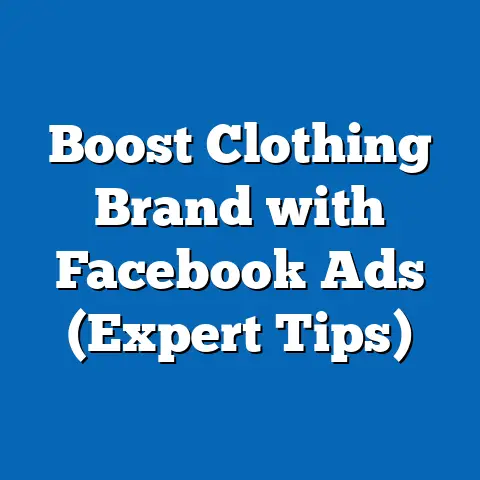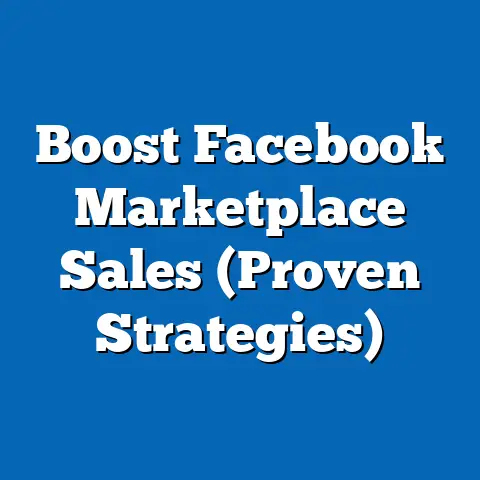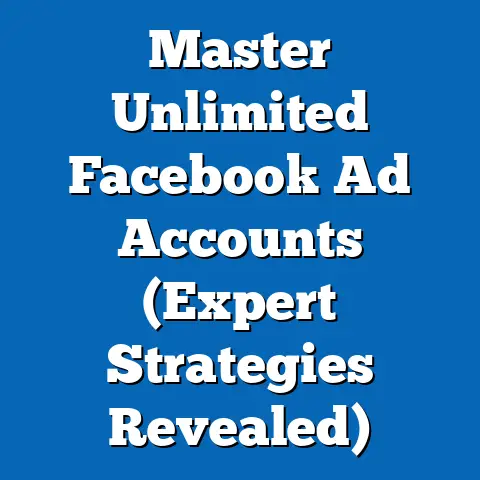Boost Facebook Ad Revenue Today (Proven Strategies Inside)
I’ve been there. Staring at the Facebook Ads Manager, feeling a mix of excitement and utter frustration. You pour your heart (and your marketing budget) into creating what you think are amazing ads, carefully targeting your audience, and crafting compelling copy. You launch your campaign with high hopes, envisioning a flood of new customers and soaring sales. But… the results are underwhelming. The ROI is barely breaking even, or worse, you’re losing money.
That feeling of disappointment, that nagging doubt that you’re missing something – I get it. It’s like standing at the foot of a mountain, knowing the summit holds incredible potential, but unsure of the best path to take.
I remember working with a local bakery owner, Sarah, who was struggling with this exact scenario. She had beautiful photos of her pastries, a clear understanding of her target market (sweet tooths in a 5-mile radius), and even offered a tempting discount code. Yet, her Facebook ads were barely generating any sales. She was ready to throw in the towel and declare Facebook ads a waste of time.
But I knew there was potential. I knew that with the right strategies, she could turn things around. And she did.
This article isn’t about quick fixes or magic bullets. It’s about understanding the Facebook advertising landscape, implementing proven strategies, and continuously optimizing your campaigns for maximum ROI. I’m going to share the same strategies I used to help Sarah and countless other businesses transform their Facebook ad performance.
So, if you’re tired of feeling like you’re throwing money into a black hole, and you’re ready to unlock the true potential of Facebook advertising, then keep reading. The time to boost your Facebook ad revenue is now.
1. Understanding the Facebook Advertising Landscape
The world of Facebook advertising is a constantly evolving ecosystem. It’s not enough to simply create an ad and hope for the best. You need to understand the platform, its users, and the common pitfalls that can derail your campaigns.
1.1 The Rise of Facebook Ads
Facebook has transformed from a social networking site into a powerful advertising platform. With billions of active users, it offers unparalleled reach and targeting capabilities. Let’s look at some key statistics that highlight the significance of Facebook advertising:
- User Base: As of early 2024, Facebook boasts over 3 billion monthly active users. This immense audience provides a vast pool of potential customers for businesses of all sizes.
- Ad Revenue: Facebook’s advertising revenue continues to grow. In 2023, the company reported over $116 billion in ad revenue, demonstrating the platform’s effectiveness for advertisers.
- Mobile Dominance: A significant portion of Facebook users access the platform via mobile devices. This underscores the importance of creating mobile-optimized ads that look great on smartphones and tablets.
- Engagement: The average Facebook user spends a significant amount of time on the platform daily, providing ample opportunities for advertisers to capture their attention.
These statistics highlight the immense potential of Facebook advertising. However, it’s important to remember that simply being on the platform isn’t enough. You need a well-defined strategy to cut through the noise and reach your target audience effectively.
1.2 Common Pitfalls
One of the biggest mistakes I see businesses make is jumping into Facebook advertising without a clear understanding of the platform. They treat it like a digital billboard, throwing up generic ads without any real strategy. Here are some common pitfalls to avoid:
- Lack of Clear Objectives: Without clear goals, it’s impossible to measure success. Are you trying to increase brand awareness, generate leads, or drive sales? Define your objectives before launching your campaign.
- Poor Targeting: Targeting the wrong audience is a surefire way to waste money. You need to understand your ideal customer and use Facebook’s targeting options to reach them effectively.
- Unengaging Ad Creative: In today’s crowded digital landscape, your ads need to stand out. Use high-quality visuals and compelling copy to capture attention.
- Ignoring Mobile Optimization: As mentioned earlier, most Facebook users access the platform on mobile devices. If your ads aren’t optimized for mobile, you’re missing out on a huge opportunity.
- Neglecting A/B Testing: A/B testing is crucial for optimizing your ads. Test different headlines, visuals, and CTAs to see what resonates best with your audience.
- Ignoring Analytics: Data is your best friend in the world of Facebook advertising. Track your results, analyze your data, and make adjustments accordingly.
Remember Sarah, the bakery owner? She was making almost all of these mistakes! Her ads were generic, her targeting was too broad, and she wasn’t tracking her results. It’s no wonder she wasn’t seeing a return on her investment.
1.3 The Importance of Data
Data is the compass that guides your Facebook advertising journey. Without it, you’re sailing in the dark, hoping to reach your destination by chance. By leveraging analytics, you can gain valuable insights into your audience, your ads, and your overall campaign performance.
Here are some key metrics to track:
- Reach: The number of unique people who saw your ad.
- Impressions: The number of times your ad was displayed.
- Click-Through Rate (CTR): The percentage of people who clicked on your ad after seeing it.
- Cost Per Click (CPC): The average cost you pay each time someone clicks on your ad.
- Conversion Rate: The percentage of people who completed a desired action (e.g., made a purchase, filled out a form) after clicking on your ad.
- Return on Ad Spend (ROAS): The amount of revenue you generate for every dollar you spend on advertising.
By tracking these metrics, you can identify what’s working, what’s not, and make data-driven adjustments to improve your results. For example, if you notice that your CTR is low, it might indicate that your ad creative isn’t engaging enough. If your conversion rate is low, it might suggest that your landing page needs improvement.
Key Takeaway: Understanding the Facebook advertising landscape is crucial for success. Avoid common pitfalls, leverage data to guide your decisions, and always be learning and adapting.
Next Step: Take some time to analyze your current Facebook advertising efforts. Are you making any of the common mistakes mentioned above? What metrics are you tracking, and what insights are you gaining from them?
2. Targeting the Right Audience
Think of your ideal customer. What are their interests? What websites do they visit? What are their demographics? The more you know about your ideal customer, the better you can target them on Facebook.
2.1 Defining Your Ideal Customer
This isn’t just about demographics. This is about understanding their motivations, their pain points, and their aspirations. It’s about creating a detailed picture of the person you’re trying to reach.
Here’s how to create detailed buyer personas:
- Gather Data: Start by gathering data from your existing customers. What are their demographics? What are their interests? What are their buying habits? You can use surveys, interviews, and analytics to collect this data.
- Identify Common Traits: Look for common traits among your customers. Are they mostly women aged 25-34 who are interested in fitness and healthy eating? Are they mostly men aged 45-54 who are interested in golf and travel?
- Create a Persona Profile: Once you’ve identified common traits, create a persona profile for each of your ideal customers. Give them a name, a face (use stock photos), and a detailed backstory. Include their demographics, interests, motivations, and pain points.
For Sarah’s bakery, we created a persona named “Sweet Tooth Sarah.” She was a 30-year-old woman who loved trying new desserts, enjoyed supporting local businesses, and often shared photos of her food on social media. By understanding Sweet Tooth Sarah’s motivations and interests, we could create ads that resonated with her.
2.2 Utilizing Facebook’s Targeting Options
Facebook offers a wide range of targeting options that allow you to reach your ideal customer with laser precision. Here are some of the most effective targeting techniques:
- Interest-Based Targeting: Target users based on their interests, hobbies, and activities. For example, if you’re selling fitness equipment, you can target users who are interested in fitness, weightlifting, and healthy eating.
- Demographic Targeting: Target users based on their age, gender, location, education, and other demographic factors. For example, if you’re selling baby products, you can target parents with young children.
- Behavioral Targeting: Target users based on their online behavior, such as their purchase history, website visits, and app usage. For example, if you’re selling travel packages, you can target users who have recently visited travel websites.
- Lookalike Audiences: Create a lookalike audience based on your existing customers. Facebook will identify users who share similar characteristics and behaviors with your customers, allowing you to reach a wider audience.
- Custom Audiences: Upload a list of your existing customers to Facebook and create a custom audience. This allows you to target your customers with specific ads, such as special offers or product updates.
With Sarah’s bakery, we used a combination of interest-based targeting (targeting users interested in desserts, local businesses, and food photography) and location-based targeting (targeting users within a 5-mile radius of her bakery). We also created a custom audience based on her existing email list.
2.3 A/B Testing for Audience Segmentation
A/B testing involves creating multiple versions of your ad and showing them to different audience segments to see which performs best. This allows you to refine your targeting and optimize your campaigns for maximum ROI.
Here are some tips for A/B testing audience segments:
- Start with a Hypothesis: Before you start testing, develop a hypothesis about which audience segment will perform best. For example, you might hypothesize that women aged 25-34 will be more responsive to your ads than men aged 25-34.
- Create Multiple Ad Sets: Create multiple ad sets, each targeting a different audience segment.
- Run Your Ads Simultaneously: Run your ads simultaneously to ensure that they’re exposed to the same market conditions.
- Track Your Results: Track your results carefully and analyze the data to see which audience segment performed best.
- Refine Your Targeting: Based on your results, refine your targeting and focus on the audience segment that generated the highest ROI.
We A/B tested different audience segments for Sarah’s bakery, comparing the performance of users interested in “desserts” versus users interested in “local businesses.” We found that users interested in “local businesses” were more likely to click on her ads and visit her bakery.
Key Takeaway: Targeting the right audience is crucial for Facebook advertising success. Define your ideal customer, utilize Facebook’s targeting options, and A/B test different audience segments to optimize your campaigns.
Next Step: Create detailed buyer personas for your ideal customers. Experiment with different targeting options on Facebook and A/B test different audience segments to see which performs best.
3. Crafting Compelling Ad Content
You’ve defined your target audience, now you need to grab their attention and persuade them to take action. This is where compelling ad content comes in. Your ad creative needs to be visually appealing, engaging, and relevant to your target audience.
3.1 The Power of Visuals
A picture is worth a thousand words, and in the world of Facebook advertising, that’s especially true. High-quality images and videos can significantly enhance engagement and drive conversions.
Here are some tips for using visuals effectively:
- Use High-Quality Images: Avoid blurry, pixelated, or poorly lit images. Use high-resolution images that are visually appealing and relevant to your product or service.
- Use Authentic Images: Avoid stock photos that look generic and impersonal. Use authentic images that showcase your product or service in a real-world setting.
- Use Videos: Videos are highly engaging and can be used to showcase your product or service in a dynamic way. Keep your videos short, concise, and visually appealing.
- Use Eye-Catching Graphics: Use eye-catching graphics, such as animations or illustrations, to grab attention and convey your message effectively.
For Sarah’s bakery, we used mouth-watering photos of her pastries, showcasing their vibrant colors and delicious textures. We also created a short video showcasing the process of making her signature croissants. These visuals significantly increased engagement and drove traffic to her bakery.
3.2 Writing Persuasive Copy
Your ad copy is your opportunity to tell your story, highlight your value proposition, and persuade your target audience to take action.
Here are some tips for writing persuasive copy:
- Write a Compelling Headline: Your headline is the first thing people will see, so make it count. Use a clear, concise, and attention-grabbing headline that highlights the benefits of your product or service.
- Focus on Benefits, Not Features: Don’t just list the features of your product or service. Focus on the benefits that your customers will receive. How will your product or service make their lives better?
- Use Strong Verbs: Use strong verbs that convey a sense of action and urgency. For example, instead of saying “Our product can help you,” say “Our product will transform your life.”
- Use Social Proof: Include social proof, such as testimonials or reviews, to build trust and credibility.
- Keep it Concise: People have short attention spans, so keep your ad copy concise and to the point. Get to the point quickly and avoid using jargon or technical terms.
For Sarah’s bakery, we used headlines like “Indulge Your Sweet Tooth” and “Experience the Best Pastries in Town.” We focused on the benefits of visiting her bakery, such as the opportunity to treat yourself to delicious desserts and support a local business.
3.3 Call to Action (CTA)
Your call to action (CTA) is the final push that encourages your target audience to take the desired action. It should be clear, concise, and compelling.
Here are some examples of effective CTAs:
- Shop Now: Use this CTA if you want people to purchase your product online.
- Learn More: Use this CTA if you want people to visit your website and learn more about your product or service.
- Sign Up: Use this CTA if you want people to sign up for your email list or create an account.
- Get a Quote: Use this CTA if you want people to request a quote for your product or service.
- Visit Our Website: Use this CTA if you want people to visit your website.
For Sarah’s bakery, we used CTAs like “Order Now” (for online orders) and “Visit Our Bakery” (for in-store visits). We also offered a special discount code for users who clicked on the “Visit Our Bakery” CTA.
Key Takeaway: Compelling ad content is essential for Facebook advertising success. Use high-quality visuals, write persuasive copy, and include a clear and compelling call to action.
Next Step: Review your existing Facebook ads. Are your visuals high-quality and engaging? Is your copy persuasive and benefit-driven? Is your call to action clear and compelling? Make adjustments as needed.
4. Optimizing Ad Placement and Budget
You’ve crafted compelling ad content and targeted the right audience. Now, it’s time to optimize your ad placement and budget to ensure that you’re reaching your target audience effectively and efficiently.
4.1 Understanding Ad Placement Options
Facebook offers a variety of ad placement options, each with its own advantages and disadvantages. Here are some of the most common ad placement options:
- Facebook Feed: This is the most common ad placement option. Your ads will appear in the news feeds of your target audience.
- Instagram Feed: Your ads will appear in the news feeds of your target audience on Instagram.
- Facebook Marketplace: Your ads will appear in the Facebook Marketplace, where users can buy and sell items.
- Facebook Right Column: Your ads will appear in the right column of the Facebook website. This ad placement option is less prominent than the Facebook Feed, but it can still be effective.
- Instagram Explore: Your ads will appear in the Instagram Explore tab, where users can discover new content.
- Messenger Inbox: Your ads will appear in the Messenger inbox of your target audience.
The best ad placement option for you will depend on your target audience, your ad creative, and your campaign objectives. For example, if you’re targeting a younger audience, you might want to focus on Instagram Feed and Instagram Explore. If you’re selling products, you might want to consider Facebook Marketplace.
For Sarah’s bakery, we focused on Facebook Feed and Instagram Feed, as these were the most popular platforms among her target audience.
4.2 Budgeting Strategies
Budgeting is a crucial aspect of Facebook advertising. You need to allocate your budget effectively to ensure that you’re reaching your target audience without overspending.
Here are some budgeting strategies to consider:
- Daily vs. Lifetime Budgets: You can set a daily budget, which is the average amount you’re willing to spend per day, or a lifetime budget, which is the total amount you’re willing to spend over the duration of your campaign.
- Bidding Strategies: Facebook offers a variety of bidding strategies, such as cost per click (CPC), cost per impression (CPM), and cost per acquisition (CPA). The best bidding strategy for you will depend on your campaign objectives and your budget.
- Budget Allocation: Allocate your budget based on the performance of your ads. If some ads are performing better than others, allocate more budget to those ads.
For Sarah’s bakery, we started with a daily budget and used a CPC bidding strategy. As we gathered data and identified the ads that were performing best, we allocated more budget to those ads.
4.3 Monitoring Performance
Monitoring your ad performance is essential for optimizing your campaigns and maximizing your ROI. You need to track your results, analyze your data, and make adjustments accordingly.
Here are some key metrics to monitor:
- Reach: The number of unique people who saw your ad.
- Impressions: The number of times your ad was displayed.
- Click-Through Rate (CTR): The percentage of people who clicked on your ad after seeing it.
- Cost Per Click (CPC): The average cost you pay each time someone clicks on your ad.
- Conversion Rate: The percentage of people who completed a desired action (e.g., made a purchase, filled out a form) after clicking on your ad.
- Return on Ad Spend (ROAS): The amount of revenue you generate for every dollar you spend on advertising.
For Sarah’s bakery, we monitored these metrics daily and made adjustments to our targeting, ad creative, and budget as needed. For example, if we noticed that our CTR was low, we would experiment with different headlines or visuals. If we noticed that our CPA was too high, we would adjust our bidding strategy.
Key Takeaway: Optimizing your ad placement and budget is crucial for Facebook advertising success. Understand the different ad placement options, use effective budgeting strategies, and monitor your performance closely.
Next Step: Review your existing Facebook ad campaigns. Are you using the most effective ad placement options for your target audience? Are you using an effective budgeting strategy? Are you monitoring your performance closely and making adjustments as needed?
5. Leveraging Retargeting and Remarketing
Imagine someone visits your website, browses your products, maybe even adds something to their cart… but then leaves without making a purchase. That’s a missed opportunity. Retargeting and remarketing are your tools to recapture those lost customers and guide them back to conversion.
5.1 The Concept of Retargeting
Retargeting is a powerful advertising technique that allows you to show ads to people who have previously interacted with your business, such as visiting your website, watching your videos, or engaging with your social media posts.
Why is retargeting so crucial for maximizing ad revenue? Because it allows you to reach people who are already familiar with your brand and are more likely to convert. They’ve shown interest, and retargeting gently reminds them of what they were considering.
Think of it like this: you’re at a store, browsing a particular item. You leave without buying it. The next day, you see an ad for that exact item on your Facebook feed. That’s retargeting in action.
5.2 Setting Up Retargeting Campaigns
Setting up retargeting campaigns on Facebook is relatively straightforward. Here’s a step-by-step guide:
- Install the Facebook Pixel: The Facebook Pixel is a small piece of code that you place on your website. It tracks the actions that people take on your website, such as visiting pages, adding items to their cart, and making purchases.
- Create Custom Audiences: Use the Facebook Pixel to create custom audiences based on the actions that people have taken on your website. For example, you can create an audience of people who have visited your product pages but haven’t made a purchase.
- Create Retargeting Ads: Create retargeting ads that are specifically designed to appeal to the people in your custom audiences. For example, you can show ads for the products that they viewed on your website or offer them a special discount to encourage them to make a purchase.
- Target Your Retargeting Ads: Target your retargeting ads to your custom audiences.
For Sarah’s bakery, we set up retargeting campaigns to target people who had visited her website but hadn’t placed an order. We showed them ads featuring her most popular pastries and offered them a 10% discount on their first order.
5.3 Success Stories
Retargeting can be incredibly effective for boosting ad revenue. Here are some examples of businesses that have successfully implemented retargeting strategies:
- E-Commerce Store: An e-commerce store saw a 20% increase in sales after implementing retargeting campaigns. They targeted people who had added items to their cart but hadn’t completed their purchase.
- Software Company: A software company saw a 30% increase in leads after implementing retargeting campaigns. They targeted people who had visited their website but hadn’t filled out a lead form.
- Local Restaurant: A local restaurant saw a 15% increase in reservations after implementing retargeting campaigns. They targeted people who had visited their website and viewed their menu.
These are just a few examples of the many businesses that have successfully used retargeting to boost their ad revenue. By targeting people who have already shown interest in your business, you can significantly increase your chances of driving conversions.
Key Takeaway: Retargeting is a powerful advertising technique that allows you to reach people who have previously interacted with your business. Set up retargeting campaigns to target people who have visited your website, watched your videos, or engaged with your social media posts.
Next Step: Install the Facebook Pixel on your website and create custom audiences based on the actions that people have taken on your website. Create retargeting ads that are specifically designed to appeal to the people in your custom audiences.
6. Staying Ahead of Trends and Algorithm Changes
The Facebook advertising landscape is constantly evolving. New trends emerge, algorithm changes are implemented, and best practices shift. To maintain a competitive edge, you need to stay informed and adapt your strategies accordingly.
6.1 The Importance of Staying Informed
Staying informed about the latest Facebook updates and industry trends is crucial for maximizing your ad revenue. Facebook regularly updates its algorithm, which can impact the performance of your ads. By staying informed, you can anticipate these changes and adjust your strategies accordingly.
Here are some ways to stay informed:
- Follow Facebook’s Official Blog: Facebook’s official blog is a great resource for staying up-to-date on the latest platform updates and features.
- Read Industry Blogs and Publications: There are many industry blogs and publications that cover Facebook advertising. Subscribe to these resources to stay informed about the latest trends and best practices.
- Attend Industry Conferences and Webinars: Attending industry conferences and webinars is a great way to learn from experts and network with other marketers.
- Join Online Communities: Join online communities of Facebook advertisers to share tips, ask questions, and learn from each other.
6.2 Adapting Strategies
Algorithm changes can significantly impact the performance of your ads. For example, a recent algorithm change prioritized content from friends and family over content from businesses. This meant that businesses had to work harder to reach their target audience.
To adapt to algorithm changes, you need to:
- Monitor Your Performance: Monitor your ad performance closely and identify any significant changes.
- Analyze the Impact: Analyze the impact of the algorithm change on your ad performance. Are your reach and impressions down? Is your CTR lower?
- Adjust Your Strategies: Adjust your strategies to adapt to the algorithm change. This might involve changing your targeting, ad creative, or bidding strategy.
For Sarah’s bakery, we had to adjust our strategies after the algorithm change that prioritized content from friends and family. We focused on creating more engaging content that would resonate with her target audience and encourage them to share it with their friends and family.
6.3 Continuous Learning and Experimentation
The key to long-term success in Facebook advertising is continuous learning and experimentation. You need to be constantly testing new strategies, analyzing your results, and adapting your approach.
Here are some tips for continuous learning and experimentation:
- A/B Test Everything: A/B test different headlines, visuals, CTAs, and targeting options to see what performs best.
- Try New Ad Formats: Experiment with different ad formats, such as carousel ads, collection ads, and lead ads.
- Explore New Targeting Options: Explore new targeting options to reach a wider audience.
- Stay Curious: Stay curious and always be looking for new ways to improve your Facebook advertising performance.
For Sarah’s bakery, we were constantly experimenting with new ad formats and targeting options. We found that carousel ads were particularly effective for showcasing her different pastries.
Key Takeaway: Staying ahead of trends and algorithm changes is crucial for maintaining a competitive edge in Facebook advertising. Stay informed, adapt your strategies, and embrace continuous learning and experimentation.
Next Step: Subscribe to Facebook’s official blog and other industry resources. Join online communities of Facebook advertisers. Start A/B testing different aspects of your Facebook ad campaigns.
Conclusion
The journey to boosting your Facebook ad revenue isn’t always easy. It requires a commitment to understanding the platform, implementing proven strategies, and continuously optimizing your campaigns. But the rewards are well worth the effort.
By defining your ideal customer, crafting compelling ad content, optimizing your ad placement and budget, leveraging retargeting, and staying ahead of trends, you can unlock the true potential of Facebook advertising and drive significant results for your business.
Remember Sarah, the bakery owner? By implementing these strategies, she was able to transform her Facebook ad performance and generate a significant increase in sales. She went from being frustrated and ready to give up to being excited and confident about the future of her business.
You can achieve the same results. The time to boost your Facebook ad revenue is now. Start testing out the strategies discussed in this article and watch your ROI soar. Don’t be afraid to experiment, to learn from your mistakes, and to adapt to the ever-changing Facebook advertising landscape. Your success is waiting.






